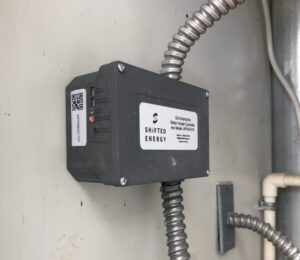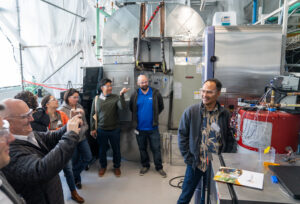Housing
May 11, 2023—The way Co-Founder and CEO of Shifted Energy Forest Frizzell explains it, the family Shifted Energy helped thought something was wrong. Shifted Energy installed a new grid connected heat pump water heater system in the home. When the family got the energy bill, they called Hawaiian Electric because the price changed in one month from $910 to $130.
“They contacted Hawaiian Electric to say: you didn’t read our meter correctly,” Frizzell said. “Hawaiian Electric assured them the bill was correct and the family was very emotional when they called us.”
The family lived in the community of Waimanalo on Oahu in Hawaii, which is part of the Department of Hawaiian Homelands, similar to a Native American reservation in the continental U.S. The area is designed for native Hawaiians, but residents cannot take advantage of typical home ownership. They own the structure of the home, but the land is leased making it difficult to attain lines of credit for upgrades like rooftop solar. The homes are often multi-generation and can have seven to 12 people living under one roof.
“They knew their solar water heater wasn’t working properly,” Frizzell said. “They didn’t have the $500 to pay a technician to figure out what the problem was. When we installed a direct load control switch and used our software to determine a baseline, we discovered leaking pipes and faulty solar panels were causing the water heater to try and heat itself from the grid for 17 hours a day.”

The Shifted Energy direct load control switch can be installed in 10 minutes. Photo courtesy of Shifted Energy
That completely changed with Shifted Energy’s system in place. Shifted Energy, which joined the Wells Fargo Innovation Incubator (IN2) program in 2019, is a platform that aggregates grid edge energy assets with a residential focus. The company uses machine learning to understand how different families use an energy asset in an effort to maximize load shaping and minimize perceived discomfort.
“We all use our water heaters differently,” Frizzell said. “You don’t want a system turning on and off a water heater without learning how a person uses it. With our approach, we are really good at knowing the boundaries of load shaping, even at the individual home so we can keep in mind the wellness and happiness of families we’re working with.”
The system also allows Shifted Energy to stack multiple grid services, leading to both load reduction and load build, giving users more flexibility for their engagement.
“We’ve also figured out how to see anomalies with a water heater’s performance,” Frizzell said. “We can see things like leaks, or if a thermostat or heating element has gone bad. Many of the multifamily operators we work with are more interested in the maintenance alerts than the cost savings they get from our system.”
Installation often does not take long. Frizzell says an electrician can install a direct load control switch in 10 minutes. They splice wires and install the module and all the commissioning is completed on the back end by Shifted Energy. This allows them to get through an entire apartment building in a week or less.

The whole Shifted Energy team visited NREL in March 2023. Photo courtesy of NREL
Working with IN2 provided Shifted Energy with lab space allowing the team to test out their theories and design strategies.
“It was a really great way to test it in an environment that was a de facto energy lab,” Frizzell said. “The whole team that we’ve been able to work with, it’s been easy; everybody does their job so well and communicates so well. It allows us to move quickly through innovation. When we went out in the community to ask people to work with us and use our technology, because of IN2, we knew it was going to work.”
Shifted Energy extended its contract with IN2 twice already and is looking at a third time. The company is also hoping to work with other startups in the IN2 portfolio. It plans to deploy some of SPAN’s panels in Hawaii and is also in conversation with BlocPower on a joint project.
“As a startup, sometimes you have big eyes and you want to work with every other company,” Frizzell said. “You can see how to weave your stories together, but it’s also really hard, because as a startup, you’re resource-constrained. We first started talking with BlocPower two years ago, and we weren’t ready then, but we are now.”

The Shifted Energy team, based in Hawaii, aggregates grid edge energy assets with a residential focus. Photo courtesy of Shifted Energy
After starting in Hawaii, Shifted Energy now works in Australia, Canada, and the continental U.S. However, in every community they work with, Shifted Energy focuses on helping to solve the affordable housing crisis. This includes working with Native Hawaiian Communities, multifamily housing managers and operators, and LMI (low-to-moderate income) communities. Frizzell says it is important to work in these areas, even though there might be a credit risk to go in and make upgrades.
“You’re often asking the most vulnerable people in our communities to pay the highest electric bills,” Frizzell said. “So those systems should be updated or retrofitted first. Everything we’ve ever done has been built with the lens of: is this is good for our community and as generations pass, will it still be good? It’s why we started with water heaters, and when we work with large-scale property managers, it’s not just the right thing to do, it’s also economical.”
While more affluent communities can invest in upgrades to clean energy systems, Frizzell says LMI communities miss out on opportunities to adapt to an increasingly complex grid. Shifted offers solutions to enable this for everyone, such as low-cost load shifting as time of use rates are implemented.
Shifted Energy is also evolving its approach into a whole-home strategy. They are expanding their system beyond water heaters to other items in the home, including thermostats, batteries, and electric vehicle chargers.
“The goal is to take what we’ve done with water heaters and expand it to the whole home,” Frizzell said. “It finally became real for me that the work we’re doing with Hawaiian Electric is the most complex that anyone is doing in that space right now, for example, load building.”
Learn more about the companies in the affordable housing space in the IN2 portfolio.
